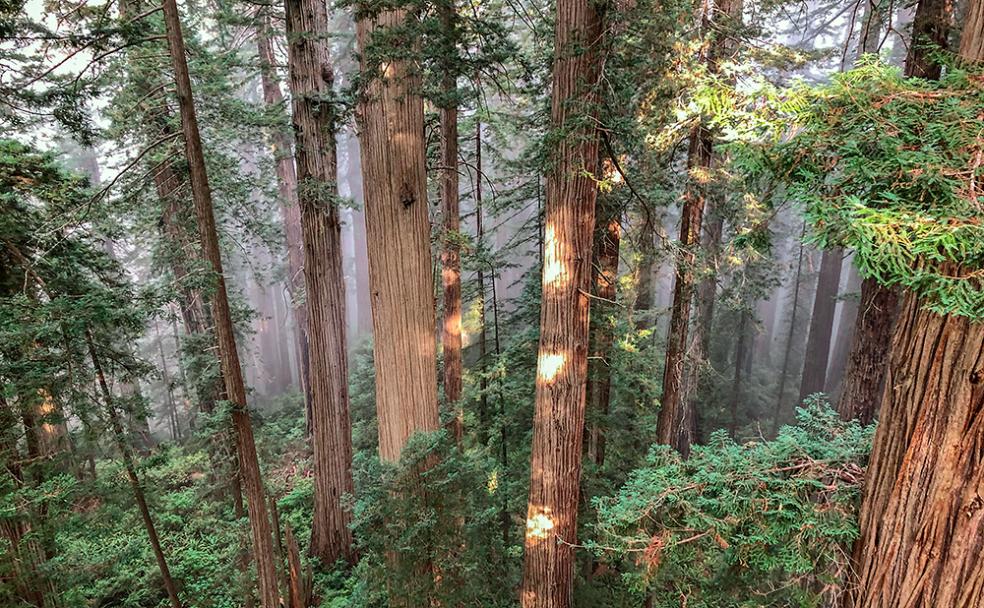
Scientists from Cal Poly Humboldt conducted a rangewide analysis of coast redwood (Sequoia sempervirens) to examine growth trends and understand how these trees are responding to recent environmental changes. They found that redwoods have varying sensitivity to drought, and that rising temperatures may affect tree performance in unexpected ways—results that are both concerning and hopeful.
The study, published in Forest Ecology and Management, was led by Cal Poly Humboldt Forestry Professor Stephen C. Sillett, the Kenneth L. Fisher Chair in Redwood Forest Ecology. Sillett’s team was funded by the Save the Redwoods League through their ongoing Redwoods and Climate Change Initiative (RCCI). This phase of RCCI was designed to investigate how redwoods across their range are responding to the changing climate, and what these responses mean for long-term carbon sequestration and biodiversity.
Sillett and team visited 45 locations spanning the redwood range from Monterey County in central California to Curry County in southern Oregon. They climbed 235 trees, measuring each one from base to top and core-sampling trunks at regular height intervals. They analyzed 1.2 million tree rings, which were crossdated by Cal Poly Humboldt dendrochronologist Allyson Carroll. Using tree ring data and intensive measurements, the researchers reconstructed tree size back through time and modeled tree performance as functions of landscape position and climate.
They found that redwoods in the north are less drought-sensitive than those in the south, but drought sensitivity is increasing across the range. Even without changes in precipitation, the redwood range is drying due to warming. The drying power of air increases exponentially with temperature, and this has important consequences for trees.
While extreme daytime temperatures can lead to death of treetops, another temperature effect inhibits tree radial growth. Nighttime temperatures are becoming unusually warm. Warmer, drier nights may reduce growth but increase tree decay resistance as excess sugars are used to produce heartwood fungicide instead of wood. The name “redwood” comes from the color of the decay-resistant chemicals in the central heartwood of a tree. The more fungicide produced, the more durable the heartwood.
While this could be a silver lining to climate change, it’s more complicated because all redwoods aren’t equal. Larger and older redwoods produce more and better heartwood. Heartwood production and fungicide content are higher in primary than secondary forests throughout the range. This means secondary forests are less effective than primary forests at long-term carbon sequestration. Only ~5% of primary redwood forests remain, and mature secondary forests are even scarcer due to repeated logging.
Managing redwoods as short-rotation crops squanders the potential of a species that can live for two millennia. Long-term carbon sequestration is one issue, and biodiversity is another. These issues are interconnected because decay-resistant heartwood creates durable habitats for canopy biodiversity.
Tree structural complexity promotes biodiversity—the largest and oldest trees host the bulk of arboreal life in a given forest, in addition to being carbon-sequestration champions. These “Elder Trees” are now rare on the landscape. However, designating Potential Elder Trees (PETs) can literally grow hope for the future.
With this approach, some of the most robust trees in a secondary forest are chosen to become part of the long-term inventory. Future land management promotes the health and vigor of Potential Elder Trees, including selective logging of crowding neighbor trees. This means production of timber and other values such as long-term carbon sequestration and biodiversity provisioning aren’t mutually exclusive in regenerating forests.
“With thick fire-resistant bark and an amazing capacity for clonal reproduction, few tree species are so well equipped to persist in an uncertain future,” the authors write. “Our actions now determine the quality of forests to be enjoyed by future generations.”